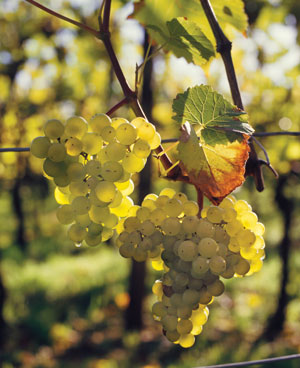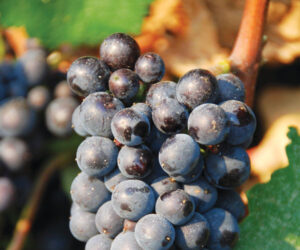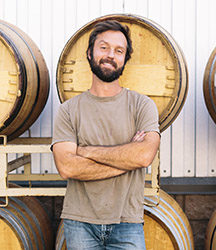
Seyval blanc (say-VAHL blahnk) is a hybrid, the product of intentional breeding to blend and express desirable traits from the parent vines. And unfortunately, hybrids often get no respect in the world of winemaking. In fact, one reference I came across in the research for this article called Seyval Blanc the “Rodney Dangerfield” of the viticultural world, in reference to the actor’s role in the film “Caddyshack.”
Hybrid grapevines, however, are something to be respected. At one point in viticultural history there was a period of uncertainty due to the root louse, phylloxera (Daktulosphaira vitifoliae). It was cutting edge vine hybridization that took center stage in an effort to battle the pest. The pest was imported to Britain and France by botanists bringing back cuttings from North America, so plant breeders sought to take the desirable character of phylloxera resistance from the North American grapevines and breed them with the desirable traits of Vitis vinifera vines.
Seyval Blanc was originally released in 1921 in Saint Vallier, Drome, France, where it was known as Seyve-Villard, named for its creators, Bertille Seyve and his son-in-law Villard. It is also referred to as Seyval, Seival, Seyve-Villard 5276, and SV 5276, but the general acceptance for wine labeling is Seyval Blanc. The plant is a cross of selections Seibel 5656 and Seibel 4986 (Rayon d’Or). Seibel is a classification of grapes originating from French viticulturist Albert Seibel (1844–1936), who was known for his work in developing phylloxera-resistant varieties. Seibel produced more than 16,000 hybrids, of which about 500 were developed into commercial varieties.
The hybrid grapevine development process is complex. The breeding process, which involves carefully introducing the pollen of one species to the female flower parts of another species, is called classical breeding. The resulting hybrids must be screened for disease resistance and grape quality. This is not an easy process — the fruit characteristics in the hybrid plant are unpredictable, and often the breeder won’t know for two to three years what the quality actually is. For example, UC-Davis is conducting ongoing research towards breeding resistance to Pierce’s Disease and powdery mildew in winegrapes using Vitis vinifera sp. and native American varietals. The current hybrids show positive genetic markers to disease resistance, but the fruit can be challenging — one recent cross with Chardonnay produced red fruit!
The other challenge of hybridization is selecting the vines for fruit that does not express the “foxy” character expressed by many North American grape varieties, and it often takes several generations to breed it out.
Unfortunately, despite the work achieved in hybridization, in the end European legislation has not permitted the use or importation of wines made from hybrid grapes, so they have fallen out of popularity. The rise of the noble grapes grown on rootstock that resist disease came out ahead due to the ease of grafting and rootstock breeding only for resistance to disease, not development of fruit quality. Alas, the market for hybrids is generally local.
As the name implies, Seyval Blanc is a white grape. It produces small berries and large clusters, often three to four bunches per shoot. It is widely reported that it has a propensity to over crop, but the great ampelographer, Pierre Galet, reports that production is usually good, although that can vary depending on soil and climate conditions. Galet also said that Seyval Blanc is capricious and subject to poor fruit set if pruned too short and over cropping if pruned too long. Growers will sometimes thin the fruit to hasten maturity in the shorter growing seasons. It is very susceptible to powdery mildew and botrytis, and moderately susceptible to bunch rot due to its large clusters. Moderate susceptibility to downy mildew, phomopsis and crown gall is also reported and grapes must be picked at maximum ripeness or they will rot. However, on the plus side, Seyval Blanc is fairly cold tolerant to over-winter temperatures, has an early bud break and subsequent maturity times, which may span only one-hundred days.
Seyval Blanc is the most popular grape along the eastern seaboard from the Carolinas up to Nova Scotia. Some have even called it, “East Coast Chardonnay.” It is well matched for regions with relatively short growing seasons and areas where Vitis vinifera will not survive the winters due to extreme cold temperatures and snow. The biggest caution is to not plant this variety in late ripening sites. Almost every winery in the Finger Lakes region of New York produces a Seyval, and it is popular also in Missouri, Michigan, and Wisconsin. There are plantings elsewhere in Canada in British Columbia, and some wineries in Oregon are experimenting with it as well. In the United Kingdom, where it has been grown since 1945, locals have given it the moniker “Save All Blanc” because of its versatility. Switzerland and Brazil also host some plantings.
The quality and style of Seyval Blanc wine is very similar to Chenin Blanc or Chablis styles, which are lighter in style, with notes of grapefruit, green apple, hay and melon. The wine produced from Seyval Blanc is best consumed young as it is not reported to be a suitable wine for aging. It is thin in the mouth, and in some cases benefits greatly from barrel fermentation and malolactic fermentation, especially if the acid is high. Some winemakers offset the thinness by making a semi-sweet version — with low alcohol, this style makes a great afternoon wine on a warm day.
At maturity, the sugars in Seyval Blanc are low — sometimes as low as 17 °Brix, depending on the season — making the grapes ideal for sparkling wines. Some winemakers will also chaptalize (add sugar to) the juice prior to fermentation.
The whole grapes do not benefit from skin contact during initial processing as the bitter tannins from the skins will show in this lighter style wine, so whole cluster pressing is best. Or, if you are crushing and de-stemming, it should be processed in batches to minimize skin contact. Home winemakers can ask their supplier about purchasing pre-processed juice.
Once fermentation is complete, you can choose to sur lie age the wine for some added body, providing that the lees are healthy. You could also consider using Seyval Blanc as a blending grape, as it can lend an acidic component to wines lacking thereof. Some growers also take advantage of its susceptibility to botrytis — for example it is sometimes a component in ice wines in Canada.
When we think of wine, we also have to think of food, and given the versatility of the wines you can make from Seyval Blanc, you have to take each case individually. The high acidity will go well with light salads and clam, oyster and mussel dishes. If there is a little residual sugar to the wine, you may find it to be better adapted to light, spicier dishes of chicken or shrimp. You could also try lobster with one of the more oaked, malolactic positive examples. If there is cheese on the table, try Havarti, Edam, or Swiss cheeses.
Seyval Blanc, depending on who you listen to, is a hybrid which plays second fiddle to the noble grapes of France, California and Australia, and frequently finds little respect outside of the locals in the regions where it is grown and wines are produced.
I have great respect, however, for the botanists and grape breeders who spend countless hours developing these types of varieties for specific regions. In some way, the disrespect shown to the variety is disrespect for those who worked so hard to rekindle grape and wine production after the devastating phylloxera epidemics in England and France. They are very patient individuals for just the time it takes to get a first crop for fruit evaluation — and even then the first crop is no more than fifty pounds or so. I commend them for their passion and dedication and also to those who respect this variety and pioneer to make the best possible examples. Be proud of your local grape because it is what will serve you best!
Seyval Blanc Recipe
(5 gallons/19 L)
Ingredients
• Fruit: 100 lbs. (45 kg) Seyval Blanc fruit, OR, 6 gallons (23 L) commercially-available clarified juice). It is best to source the juice locally. I found several references to juice sales by local wineries in the Midwest and East. Note: If you are using fresh juice, skip to step 4.
• Distilled water
• 10% potassium metabisulfite (KMBS) solution. (Weigh 10 grams of KMBS, dissolve into about 75 milliliters (mL) of distilled water. When completely dissolved, make up to 100 mL total with distilled water.
• 5 grams Lallemand QA23 yeast (Premier Cuvee can also be used as a substitute)
• 5 grams Fermaid K (or equivalent yeast nutrient)
• 5 grams Di-ammonium phosphate (DAP)
• Potassium carbonate
Other equipment or needs
• 5-gallon (19-L) carboy
• 6-gallon (23-L) carboy
• 6-gallon (23-L) plastic bucket
• Airlock/stopper
• Racking hoses
• Equipment cleaning and sanitizing agents (Bio-Clean, Bio-San)
• Inert gas (nitrogen, argon or carbon dioxide will do)
• Refrigerator (~45 °F/7 °C) to cold settle the juice. (Remove the shelves so that the bucket will fit.)
• Ability to maintain a fermentation temperature of 55 °F (13 °C) TIP: Use a 33-gallon (125-L) plastic can as a water bath. Place ice blocks in the water to maintain a relatively constant temperature. This will be your refrigeration system for peak fermentation. If you have other means to keep things cool, of course use that. TIP: you may have a need to keep it warm, in this case wrapping the bucket/carboy with an electric carboy wrap (available at most home winemaking outlets) works well.
• Thermometer capable of measuring between 40–110 °F (4–43 °C) in one degree increments
• Pipettes with the ability to add in increments of 1 milliliter
• Clinitest® tablets to measure residual sugar at the completion of fermentation
• Ability to test, or have testing performed, for sulfur dioxide
Step by Step
1. Crush and press the grapes. Do not delay between crushing and pressing. Move the must directly to the press and press lightly to avoid extended contact with the skins and seeds.
2. Transfer the juice to a 6-gallon (23-L) bucket. During the transfer, add 16 milliliters of 10% KMBS solution (This addition is the equivalent of 40 mg/L (ppm) SO2). Move the juice to the refrigerator.
3. Let the juice settle at least overnight. Layer the headspace with inert gas and keep covered.
4. Measure the Brix. Ideal styles of this wine are around 11% alcohol, which is produced when the sugar is around 18 °Brix. Higher Brix will produce higher alcohol wines. You certainly do not want anything greater than 13% alcohol. If the Brix is low, add cane sugar (sucrose).
5. Adjust the acidity to 0.6–0.7 or 6–7 g/L. Given the high acidity of this grape, you will probably have to de-acidify using potassium carbonate. See www.enartisvinquiry.com/download/PROTOCOL/Deacidification%20trial.pdf for information on how to de-acidify the juice.
6. When sufficiently settled, rack the juice off of the solids into the 6-gallon (23-L) carboy.
7. Prepare yeast. Heat about 50 mL distilled water to 108 °F (42 °C). Measure the temperature. Pitch the yeast when the suspension is 104 °F (40 °C). Sprinkle the yeast on the surface and gently mix so that no clumps exist. Let sit for 15 minutes undisturbed. Measure the temperature of the yeast suspension. Measure the temperature of the juice. You do not want to add the yeast to your cool juice if the temperature of the yeast and the must temperature difference exceeds 15 °F (8 °C). To avoid temperature shock, acclimate your yeast by taking about 10 mL of the juice and adding it to the yeast suspension. Wait 15 minutes and measure the temperature again. Do this until you are within the specified temperature range. Do not let the yeast sit in the original water suspension for longer than 20 minutes. When the yeast is ready, add it to the fermenter.
8. Add Fermaid K or equivalent yeast nutrient.
9. Initiate the fermentation at room temperature ~(65–68 °F/18–20 °C) and once fermentation is noticed, (~24 hours) move to a location where the temperature can be maintained at 55 °F (13 °C).
10. Two days after fermentation starts, dissolve the DAP in as little distilled water required to completely go into solution (usually ~ 20 mL). Add directly to the carboy.
11. Normally you would monitor the progress of the fermentation by measuring Brix. One of the biggest problems with making white wine at home is maintaining a clean fermentation. Entering the carboy to measure the sugar is a prime way to infect the fermentation with undesirable microbes. So at this point, the presence of noticeable fermentation is good enough. If your airlock becomes dirty by foaming over, remove it and clean it and replace as quickly and cleanly as possible. Sanitize anything that will come in contact with the juice.
12. Leave alone until bubbles in the airlock are about one bubble per minute. Usually about two to three weeks. Measure Brix every 2–3 days.
13. The wine is considered dry, or nearly dry when the brix reached -1.5 brix or less. Measure the residual sugar using the Clinitest®. When the result is less than 0.5%, add 15 mL of fresh KMBS (10%) solution per gallon of wine. This is the equivalent to ~40 ppm addition. Transfer the wine to the five gallon carboy and lower the temperature to 38–40 °F (3–4 °C).
14. After two weeks, test for pH and SO2 adjust as necessary to attain 0.8 ppm molecular SO2. (There is a simple SO2 calculator on the Web at www.winemakermag.com/guide/sulfite). Check the SO2 in another two weeks, prior to the next racking and adjust while racking. HINT: Rack to another sanitized 5-gallon (19-L) carboy, or your bucket. In the case of the latter, clean the original carboy and transfer the wine back to it. This is done at about 4–6 weeks after the first SO2 addition. Once the free SO2 is adjusted, maintain at the target level by monitoring every 3–4 weeks.
15. It is possible you may experience a protein haze, so bentonite fining is recommended. Consult winemakermag.com for tips on fining and filtration.
16. At about three months you are ready to bottle. Be sure to always maintain sanitary conditions while bottling. Once the wine is bottled, you will need to periodically check your work — try doing this by opening a bottle to enjoy with friends.
Sulfur Dioxide Additions:
The recipe calls for specific additions of sulfur dioxide at specified intervals. Once these scripted additions are made, you must monitor and maintain at the target concentration; adjusting as necessary using the potassium metabisulfite solution previously described or by methods of your own choosing. Testing can be done at a laboratory, or at home.







